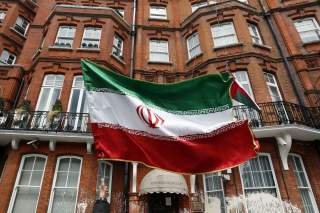Obama's Middle East Policy Is Causing Problems for Donald Trump
Left untouched, the nuclear agreement ensures—rather than prevents—Iran from getting nuclear weapons within the next few years.
The president will apparently pursue a middle solution between the two poles of the Republican party where noncertification puts Europe and Iran on notice that the United States is prepared to walk away from the deal if new provisions are not added and the flaws remain unfixed. From a political standpoint, it also lessens the controversy involved in the quarterly public certification process and provides an opportunity to change that requirement, which is something he is reportedly keen to pursue. By not certifying Iran, America’s threat to walk away from the deal and reimpose of a range of sanctions—pertaining to Iran’s nuclear activity or to other behavior—will form the basis of the new leverage to strengthen the deal as many advising him advocate.
In policy circles, the idea is called, “waive, decertify and fix.” Those more eager to impose costs to Iran add a “slap,” making it a “waive, decertify, slap and fix” approach. Provisions keeping sanctions in place are waived, President Trump decertifies the deal according to the INARA, Congress slaps new sanctions on the regime in Tehran, and then they’ll attempt to fix the deal.
Policy Implications
Fixing the fatal flaws in the deal would be a very steep climb for the Trump administration, even during the best of circumstances with the most seasoned diplomats guiding the ship of state. As it stands today, for a variety of reasons, the State Department has gone rogue on the issue of Iran and is in open war with the White House. For the administration’s plan to work, the United States will first need to find common ground between the P5+1 members (or as many as possible) and then present a united front to an Iran that has already gorged itself on the front-loaded goodies the Obama administration already gave away.
From Tehran’s perspective, there will be no carrots enticing enough to renegotiate key provisions of the deal, even though that is precisely what Europe will seek to offer. It will then boil down to sticks—and America may have the only one sufficiently threatening to perhaps coax an Iranian change of heart. That is why many on the political Right are calling for the United States to simply walk away from the deal and move on to the stick approach. They believe any carrot-based approach will be a costly waste of time.
There is no pause button. If the United States remains in the agreement while exploring additional means to strengthen the deal, then Iran can simply play for time until the sunset clauses run out. If Iran bolts from the deal in response to America’s decertification—which is unlikely given just how lopsidedly beneficial it is for Iran to patiently remain loosely affiliated with the agreement—then all the United States has is a military option that it will need to be prepared to use sooner than later. The question then will be: is there a military solution that prevents Iran from acquiring nuclear weapons?
While those urging Trump to abandon the agreement entirely must be banking on a military solution as an effective tool of last resort, those who want to remain in the agreement without seeking fixes have fallen through the looking glass and are willing participants in a dangerous fantasy they’ve come to mistake for reality. It reflects an inability to separate expedient political rhetoric from a technical and policy-based reality that has become increasingly apparent in the past two years. No amount of stale talking points can disguise the deal’s shortcomings.
One final caveat: President Trump is not known for his conformity to conventional wisdom or thinking, or even the words he has uttered in a sentence or tweet. That means that even though Washington and Europe are gearing up to react to Trump’s likely decision not to certify by the October 15 deadline, he can always wake up one morning and decide to pursue a completely different path. As with any administration, the actions taken will speak louder than the promises made. As Yogi Berra used to say, “It ain’t over till it’s over.”
It remains to be seen whether President Trump’s decision represents a tactical move to placate his political base or is part of a larger U.S. strategic objective regarding Iran and the wider Middle East.
Matthew RJ Brodsky is a senior fellow at the Security Studies Group in Washington, DC, and a Senior Middle East Analyst at Wikistrat. He can be followed on Twitter: @RJBrodsky.
Image: A voter holds a flag outside the Iranian consulate in central London June 14, 2013. The building was the focus for demonstrators, as it was used as a venue for British based Iranians to cast their vote in their country's election to choose a new president. REUTERS/Stefan Wermuth
RECOMMENDED:
What a What a War Between America and China Would Look Like.

